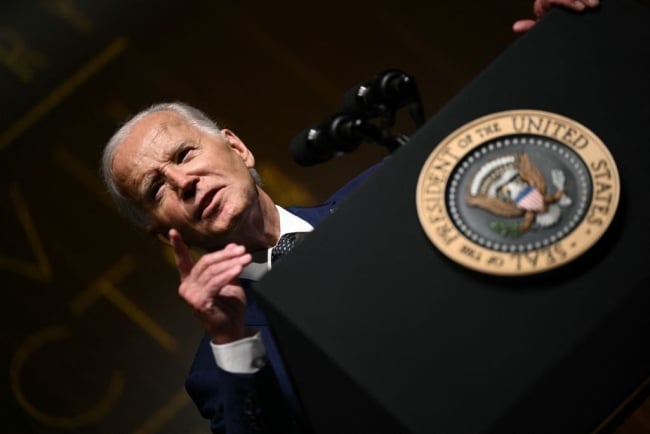You have /5 articles left.
Sign up for a free account or log in.

President Biden promised to roll back Trump-era Title IX changes immediately. Nearly four years later, his plans are tied up in the courts.
Brendan Smialowski/AFP via Getty Images
A little more than 100 days ago, the Biden administration finalized its overhaul of Title IX of the Education Amendments of 1972, which promised to usher in a new era for the federal civil rights law with greater protections for LGBTQ+ students and those who are pregnant, as well as new measures aimed at better supporting victims of sexual harassment.
Complying with the rule by Aug. 1 would have been a lift for overtaxed Title IX offices in the best of times. But the new rule has run headlong into a divisive national debate about diversity, equity and inclusion and the rights of transgender individuals—complicating colleges’ efforts to comply and raising the stakes for officials in Republican-led states who do. (One Title IX administrator in Texas was suspended after telling a student newspaper that her university would follow the new regulations.)
Some state leaders have told their colleges to not comply with the regulations, and 26 Republican attorneys general have challenged the regulations in court. So far, they’ve won seven temporary injunctions that prevent the Education Department from enforcing the regulations in those 26 states, and on hundreds of campuses in the others. Two injunctions were handed down the day before the regulations went into effect.
Outside of the lawsuits, U.S. House Republicans have tried to overturn the rule nationally, arguing that the changes exceed the department’s authority and that they’d undermine Title IX’s protections for cisgender women and girls.
Republican officials and conservative groups mostly take issue with a provision in the new rule that clarifies that sex-based discrimination prohibited under Title IX includes discrimination based on sexual orientation and gender identity—as well as another change that would allow transgender students to use the bathroom or locker room consistent with their gender identity.
Louisiana senator Dr. Bill Cassidy called the rule “the death of Title IX.” The top Republican on the Senate education committee, Cassidy has introduced a resolution in the Senate to overturn the regulations.
“The new Biden-Harris rule injects progressive gender ideology into Title IX, weakening long-standing protections for women and girls,” Cassidy said. “Thankfully, Louisiana and other states have taken action to block President Biden and Vice President Harris’s assault on Title IX in their schools. This policy needs to be ended nationwide to ensure women and girls have every opportunity to succeed on the field and in the classroom.”
Cassidy’s resolution is unlikely to move forward in the Democratic-controlled Senate. But judges have agreed with Republican arguments about the regulations, creating a patchwork of implementation—and sowing confusion among Title IX administrators.
How did the Biden administration’s much-anticipated Title IX overhaul, in the works for three years, wind up at this point? To understand that, it helps to go back to the beginning.
A Campaign Promise
While campaigning for president in 2020, Joe Biden promised to immediately overturn the Title IX changes put in place by the Trump administration, which were finalized in May 2020 and took effect that August. The Trump administration narrowed the definition of sexual harassment and added new measures to ensure the due process rights of students accused of misconduct, over the objections of students and advocacy groups who argued that the changes harmed those who experience sexual harassment and violence and made it less likely that survivors would report what happened to them.
Despite his promise, Biden didn’t take any immediate action to address the Trump Title IX rules. But his administration did quickly start to work on rewriting the regulations, holding public hearings about the issue in June 2021.
The proposed changes were rolled out in June 2022—the most controversial of which strengthened protections for LGBTQ+ students. Thousands of public comments—a little over 240,000—poured into the Education Department.
Finalizing the Changes
Reading and responding to those comments took time. The final Title IX regulations were expected in May 2023, but the department pushed back that target date a few times before issuing a final rule April 19.
The regulations were largely similar to what the department had proposed: The changes lowered the standard for what constitutes sexual harassment and expanded most elements of what colleges are required to do under Title IX, from increasing reporting and recordkeeping responsibilities to broadening the types of harassment that an institution must respond to and investigate.
Critics decried the rollback of the Trump rules, arguing it was unnecessary and would infringe on the rights of students accused of misconduct. The Biden rule ended the 2020 requirement that colleges hold live hearings with an opportunity for cross-examination to allow those accused to confront their accusers. But the fiercest opposition was focused on the provisions related to LGBTQ+ students.
Swift Pushback
Conservative groups wasted no time announcing plans to challenge the new regulations in court. They railed at what they deemed an illegal redefinition of the decades-old law that prohibits discrimination based on sex and framed it as a “slap in the face to women and girls who have fought long and hard for equal opportunities,” in the words of Rachel Rouleau, legal counsel for Alliance Defending Freedom, a conservative legal organization that sued over the rule.
The first lawsuits were filed April 30, and others soon followed. In the end, 26 Republican attorneys general along with several conservative organizations sued the Biden administration in seven separate lawsuits. The lawsuits mostly focused on the new protections for transgender students.

A conservative group opposed to the Title IX changes organized a summer bus tour to rally against the participation of trans athletes in women’s sports.
Aimee Dilger/SOPA Images/LightRocket via Getty Images
“There is normal federal government overreach—and then there is the final rule: a naked attempt to strong-arm our schools into molding our children in the current federal government’s preferred image of how a child should think, act, and speak,” four states argued in one lawsuit that resulted in the first injunction. “The final rule is an affront to the dignity of families and school administrators everywhere, and it is nowhere close to legal.”
The Biden administration has countered that its decision to strengthen LGBTQ+ protections is in line with Supreme Court precedent and the changes are well within the department’s authority.
Injunctions Pile Up
By the end of June, with a month to go before the regulations took effect, federal judges had blocked the department from enforcing the Title IX changes in 10 states, finding the plaintiffs were likely to succeed in their legal challenges.
The judges didn’t hold back in their criticism of the Biden administration’s actions. They said that the rule “wreaks havoc” on Title IX, would “derail deeply rooted law” and was an “abuse of power.” The court orders put the whole rule on hold despite the fact that only a handful of provisions had been challenged.
The Biden administration quickly appealed the injunctions but wasn’t initially successful in its efforts to reverse the court orders. Lawyers for the Biden administration also requested that the courts allow the parts of the regulations that aren’t challenged such as new protections for pregnant or parenting students to move forward—with no luck so far.
The steady beat of injunctions continued during July, right up until one day before the regulations were to take effect. By the end of last month, judges had blocked the regulations in 26 states.
A Complicated Court Order
Most of the court orders were fairly simple, applying only to the states that sued. But a lawsuit involving Alaska, Kansas, Utah and Wyoming as well as three conservative organizations complicated matters.
The injunction handed down July 8 applied to the four states and any school or college attended by members of the organizations—Young America’s Foundation, Female Athletes United and Moms for Liberty. The groups urged individuals to sign up as members following the court ruling and later provided a document to the court listing where their members are located. More than 670 colleges and universities were affected, including many in big blue states like California, and that list could continue to grow as they add members. Any college on the list doesn’t necessarily have to comply with the new regulations.
Experts said the order amounts to a nationwide injunction, and the judge in the case suggested the department delay enforcement of the regulations. So far, the department has declined to do so.
The Biden administration is currently making its case before the Supreme Court to allow parts of the rule to take effect while litigation continues, and several experts think that the high court will have to ultimately settle the questions raised in the states’ lawsuits.
The conservative challenges have left the ultimate fate of the new Title IX rule uncertain. For now, colleges—and the students the Biden administration aimed to protect—are left in limbo, waiting for clarity.




